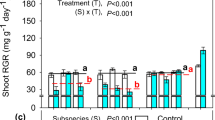Summary
Because of the strategic and industrial importance of natural rubber, there has been renewed interest in cultivating guayule (Parthenium argentatum). This study was performed for assessing feasibility of guayule cultivation with waters high in dissolved salts. The test materials included six USDA selections (11591, 11605, 11619, 11646, 12229 and N576), one cultivar (593) and one hybrid (4265XF). Seedlings were grown for l0 weeks in a greenhouse and transplanted in the spring and in the summer into lysimeters (unit surface dimension of 6 x 7 m) containing loamy sand or silt loam. They were grown with simulated irrigation waters having four levels of salinity (0.8, 2.4, 4.6 and 7.2 dSm−1 with SAR < 13) and an additional water containing 5 mmol L−1 of Mg at 2.4 dSm−1. In the spring planting, over 90% of the transplants survived when furrow irrigated weekly with waters of 4.6 dSm−1 or less. However, transplant growth for the first several months was reduced by half at irrigation water salinity of 4.6 dSm−1. In the summer planting, several fold increases in mortality and growth reduction occurred. Dry top Shrub yields after the two growing seasons following the spring planting averaged 10 Mg ha−1 at 0.8 dSm−1 and declined on the average 15 and 51 % when irrigated with waters of 4.6 and 7.2 dSm−1 respectively. The amount of water used to produce one ton of dry shrub was 1,600 m3 with waters of 0.8 and 4.6 dSm−1, and 1,900 m3 with water of 7.2 dSm−1. The contents of rubber in the shrubs averaged 61 g kg−1 at 0.8 dSm−1 and increased to 70 g kg−1 at 7.2 dSm−1. whereas resin contents were not affected by the salt treatments. Resulting rubber yields were reduced on the average by 8.5 and 44% at 4.6 and 7.2 dSm−1. respectively, because of the reduction in shrub yields. Selection N576 produced the largest rubber yields with the highest rubber content at all levels of salinity. Increasing Mg concentrations from 0.5 to 5 mmol L−1 in the irrigation waters reduced neither yields nor transplant survival. Yield reductions observed here appeared to be related to Na, but not Mg.
Similar content being viewed by others
References
Chapman H, Pratt P (1961) Methods of analysis for soils, plants, and waters. University of California, Riverside
Cottenie A (1980) Soil and plant testing as a basis of fertilizer recommendations. Food and Agricultural Organization of the United Nations, Rome, p 97
La Hye P, Epstein E (1969) Salt tolerance by plants; Enhancement with calcium. Science 166:295
Miyamoto S (1979) Salinity problems in irrigated areas of Texas. In: O'Connor GA (ed) Proceedings of the 2nd Int.-Am. Conference on Salinity and Water Management Tech. Juarez, Mexico, p 10
Miyamoto S, Piela K, Davis J, Fenn L (1984a) Salt effects on emergence and seedling mortality of guayule. Agron J 76:295
Miyamoto S, Davis J, Piela K (1984b) Water use, growth and rubber yields of four guayule selections as related to irrigation regimes. Irrig Sci 5:95
National Academy of Science (1977) Guayule: An Alternative source of natural rubber. Natl Acad Sci Washington, DC
Penman H (1963) Vegetation and hydrology. Tech Commun No 53. Commonw Bur Soils. Harpenden, Eng, p 125
Retzer J, Mogen C (1946) The salt tolerance of guayule. J Am Soc Agron 38:728
Tipton J, Gregg E (1982) Variation in rubber concentration of native Texas guayule. Hort Sci 17:742
US Salinity Laboratory Staff (1954) Diagnosis and improvement of saline and alkali soils. In: Richards LA (ed) Agricultural Handbook 60 USDA
Wadleigh C, Gauch H (1944) The influence of high concentrations of sodium sulfate, sodium chloride, calcium chloride and magnesium chloride on the growth of guayule in sand culture. Soil Sci 58:399
Author information
Authors and Affiliations
Additional information
Contribution from Texas Agricultural Experiment Station. Supported in part by a grant from the Latex Commission, USDA and by the US-Israel Binational Agricultural Research and Development (BARD) fund
Rights and permissions
About this article
Cite this article
Miyamoto, S., Piela, K. & Gobran, G.R. Salt effects on transplant mortality, growth and rubber yields of guayule. Irrig Sci 5, 275–284 (1984). https://doi.org/10.1007/BF00258180
Received:
Issue Date:
DOI: https://doi.org/10.1007/BF00258180




